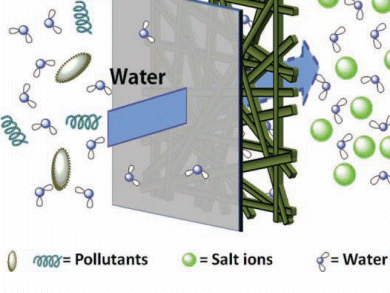Forward osmosis (FO) is a well-recognized osmotic process for producing clean water because of the low energy input. Conventional FO membranes are composed of a thin active layer on top of a thick support layer. The thick support layer gives rise to an internal concentration polarization (ICP) problem that ultimately slows the flux of water from one side to the other.
To increase water flux, Darren Delai Sun and colleagues, Nanyang Technological University, Singapore, have developed a novel nanocomposite FO membrane with a scaffold-like nanofiber support layer. This support layer has high porosity and is very thin. It consists of nanofibers of polyethersulfone applied to a nonwoven fabric by a rotating drum setup. It has an interconnected pore structure which is superior to conventional support layers’ sponge-like structure. This open structure allows it to overcome the ICP problem, resulting in high water production rates and energy savings.
Image: (c) Wiley-VCH




